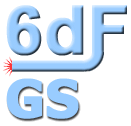
|
|
|
|
|
|
|
|
|
|
|
|
|
|
|
|
|
|
|
|
|
 | |
 | |
| IFA ROE |
Help page for 6dFGS query form
Explanation of parameters used in the 6dfGS QUERY FORM and SQL box form access pages. Some parameters are only available on one of the forms.
- 1st Select box:
Enter the parameters to extract from the
primary table in the text box. Parameters should be separated by commas, eg
if the primary table is SPECTRA you could enter
obsra,obsdec,z_helio,quality
Enter * to select all parameters from the primary table.
Parameters and tables are listed here.
- 1st From menu: choose primary table to
query from drop down menu.
Parameters and tables are listed here .
- 2nd Select box:
Enter the parameters to extract from the
secondary table in the text box. Parameters should be separated by commas, eg
if the secondary table is SUPERCOS you could enter
ra,dec,mag_1
Parameters and tables are listed here.
- 2nd From menu: choose secondary table to query from drop down menu.
Parameters and tables are listed here .
- Pairing menu: If querying two tables choose pairing option from drop down menu. Either only return matching objects in
both tables or return all objects selected in primary and give secondary
data where available. Tables are paired using the targetid parameter
present in all tables.
- Where: enter constraints to place on query
in text box. eg if SPECTRA is one of the tables
being queried you could enter targetid > 0 and z > 0.1 and quality > 2
If querying two tables you might need to precede the parameters with the relevant table name and a dot to uniquely specify it as some tables share the same names for parameters. eg spectra.targetid > 0 and z > 0.1 and quality > 2
Parameters and tables are listed here.
- Order by: if you want to sort your
output
on a given parameter than enter its name in this text box, you can
also specify asc (ascending, the default) or desc (descending).
If querying two tables you might need to precede the parameter(s) with the relevant table name and a dot to uniquely specify it as some tables share the same names for parameters. eg twomass.ra desc. To sort on more than one parameter separate the clauses with commas eg spectra.targetid asc, spectra.quality desc
Parameters and tables are listed here.
- RA, DEC, Equinox and radius: to perform
a radial search enter values for RA, DEC and search radius in arcmin.
Only objects with targetid > 0 are returned (objects with targetid=0
are not in the master target configuration file). The RA and Dec
can be entered as sexagesimal (hh:mm:ss.s dd:mm:ss.s) or decimal degrees.
Specify the equinox
of the input coordinates, all coords are output as J2000.
- Output RA and DEC: check this box
to output returned RAs and DECs as decimal degrees rather
than sexagesimal.
- NROWS: enter the maximum number of rows returned in any HTML
table. There is a hard-wired maximum of 100 as HTML tables
are only really useful if the user is able to take-in the data
by eye. If you want more rows you'll need to select CSV output and
download the file. Be warned Netscape on Unix struggles with large HTML tables
so reduce the load by only outputting the columns/rows you need.
The query stops once when nrows
has been returned even if the query would have produced more.
- FORMAT: choose HTML or a comma-separated value (CSV) file.
If CSV is selected ALL rows (NOT just nrows) are returned by the query and written to the
CSV file which is then made available for download.
- CSV compression: do you wish the CSV file to be gzipped?
- TAR: if you select yes, then the query is performed and a
link to a TAR saveset of FITS files matching the returned objects is
outputted to the browser
after the HTML summary table. Note the number of rows written to the
CSV
and the resultant implications for the size of the TAR file. The size
of the TAR file has been limited to 500 FITS files.
NB you must specify CSV as the data format and provide a valid
email address. For the TAR to work you must ensure that
targetname
is one of the returned parameters.
- EMAIL: if you've requested a TAR saveset
of object FITS files then enter an email address.
- SQL query: Enter you SQL query in the box. An example is provided, delete this when adding your own.
Home | Intro | Schema | Access | FITS files
WFAU, Institute for Astronomy,
Royal Observatory, Blackford Hill
Edinburgh, EH9 3HJ, UK
Tel +44 131 668 8356 (office)
or +44 131 668 8100 (switchboard)
6dfdata@aao.gov.au
26/8/2008